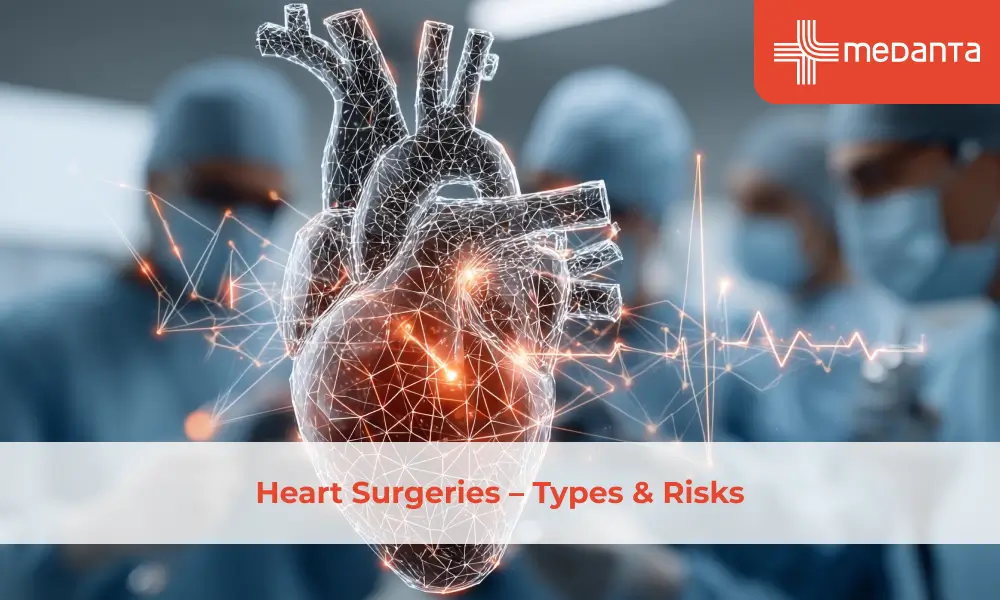Heart Surgeries – Types & Risks

Heart Surgeries - Types & Risks
The percentage of the population diagnosed with cardiovascular diseases (CVDs) in India has been increasing sharply every year. Another major concern is the growing number of young Indians suffering from CVDs. Hypertension, diabetes, smoking, physical inactivity, obesity, etc., are being identified as the conventional risk factors contributing to the increased prevalence of heart diseases amongst Indians.
As a leading multispecialty hospital in India and recognised as amongst the best hospitals for heart surgery, Medanta is committed to spreading awareness and sharing expert insights on various healthcare topics, the management of various diseases, and more.
In this blog, we will share the most common types of heart surgery and the common risks associated with them.
What is heart surgery?
While a person may be affected by some kind of heart-related problem, not all such problems would require them to undergo surgery. Maintaining a healthy lifestyle, taking medication prescribed by expert doctors in the field, or undergoing some non-surgical or minimally invasive procedures may help in managing heart conditions.
However, in cases such as compromised heart functioning due to partial or complete blockage of a coronary artery, faulty heart valves, abnormal heart rhythms, or heart failure, the patients may be recommended to undergo heart surgery. The cardiac specialists suggest the type of heart surgery depending upon the heart problem, the patient’s age, and other health factors. Below are the various types of open heart surgery and other heart procedures.
Types of Open-Heart Surgery
In open-heart surgeries, the cardiac surgeons make an incision in the chest to open the rib cage, and usually an artificial heart is connected to the patient while the surgery is performed.
The common open-heart surgery procedures include:
- Heart Bypass Surgery
Heart bypass surgery is used to treat heart blockages caused by plaque (a waxy substance) buildup inside the arteries, narrowing them and obstructing blood and oxygen flow to the heart. Under this procedure, the heart surgeon takes a healthy vein or artery from your other body part and then grafts it, i.e., connects it to the blocked coronary artery to supply blood. This way, the newly grafted artery bypasses the coronary artery, helping blood flow unobstructed to the heart. In most cases, the procedure involves the grafting of more than one or two coronary arteries.
*Please get in touch with us via our website, here, to consult our team and know the heart bypass surgery cost.
- Surgery for Aneurysm Repair
The wall of an artery or a heart muscle may bulge out like a balloon. This bulge, referred to as an aneurysm, may grow with time and burst, leading to internal bleeding that may become fatal. Aneurysm repair necessitates surgery in which the surgeon replaces the damaged portion of the artery or wall with a patch or a graft.
- Heart valve repair or replacement surgery
Valves of a healthy heart open and close via flaps called "leaflets" to allow blood to flow from one heart chamber to another and into arteries. If the leaflets don’t open or close properly, enough blood may not flow or the blood may leak back into the valves. To fix such problems, the heart surgeon may recommend either valve repair or replacement surgery.
- Heart Transplant
A heart transplant is typically regarded as a last resort for a failing heart becoming necessary for the patient whose heart is irreversibly damaged and the only chance of survival is through the implanting of a healthy heart from an organ donor. It’s a long surgery that lasts for a couple of hours, and even after the surgery, the patient is kept under strict supervision in an ICU with attached drainage tubes to eliminate any excess fluid from the chest cavity.
- Surgery for insertion of VAD or TAH
In the case of a patient with a weak heart, the surgeon may suggest implanting a mechanical pump called a Ventricular Assist Device (VAD) to support heart function and proper blood flow. On the other hand, Total Artificial Hearts (TAH) is a device used to replace both the lower ventricles that become weak, mostly due to heart failure. Insertion of either of these devices requires the patient to undergo open-heart surgery.
Other Cardiac Procedures
Instead of cutting through the breastbone like in open-heart surgery and using artificial, minimally invasive heart surgery, the surgeon makes small incisions in the right side of the chest to reach the heart. It may be done for the following procedures:
- Stent placement
During the angioplasty procedure, a wire-mesh tube called a stent is placed in the artery to open the blockage and improve blood flow.
- Transmyocardial Laser Revascularization (TMR)
In patients that do not qualify for heart bypass surgery or angioplasty, the surgeons may recommend a TMR procedure to relieve the severe chest pain. Under this, laser technology is used to drill holes into the heart’s pumping chamber.
- Cardiac catheterization
For this procedure, a very thin, hollow, and flexible tube called a catheter is inserted through a blood vessel into the heart. The inserted tube is used by the surgeon to examine the functioning of the heart, diagnose any underlying heart condition, and even treat some of the conditions like irregular heart rhythms, clogged arteries, etc.
Risks Associated with Heart Surgery
Being a major surgery, any kind of heart surgery carries certain risks that may include but aren’t limited to the following:
- a) Bleeding
- b) Arrhythmias, i.e., irregular heartbeats
- c) Memory loss or any other type of cognitive impairment
- d) Infection in the site of surgery
- e) Chances of stroke
- f) Side-effect of anaesthesia
- g) Heart/Kidney/Liver/Lung tissue damage
Patients with underlying or multiple other diseases, like diabetes, etc., may be at a higher risk of complications during or after heart surgery.
Conclusion
At Medanta, we have a vast team of top heart specialists and surgeons in the country, equipped with the most advanced technology and state-of-the-art infrastructure, enabling us to obtain phenomenal success rates in heart surgeries.






